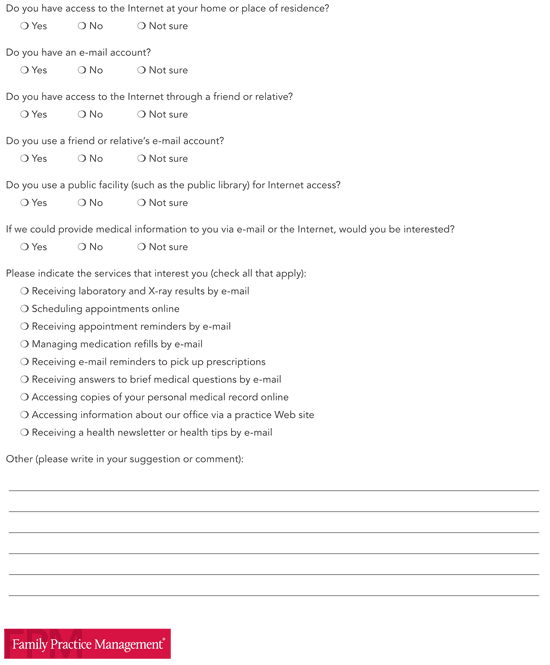
This simple survey will help you gauge patients' ability to interact with your practice via the Internet.
Fam Pract Manag. 2007;14(9):25-27
Dr. Pelletier is assistant professor of family medicine with the Saint Francis Family Medicine Residency Program and University of Tennessee College of Medicine, Memphis. Gregg Sutton is a third-year medical student at the University of Tennessee College of Medicine, Memphis. Dr. Walker is associate professor and acting chair in the Department of Family Medicine, University of Tennessee College of Medicine, Memphis. Author disclosure: nothing to disclose.
Much has been written about helping physicians embrace the tools of the information age for better patient care and office management. But are our patients ready for this kind of change? Are your patients ready? And how would you know? Our practice struggled with this dilemma. Using the Internet to communicate with patients sounded wonderful, but a significant number of our patients are poor, elderly, uninsured or handicapped. We did not want to cross the digital divide only to leave some patients behind – those unable to access a computer.
To find out whether our patients were willing and able to use e-mail and various Web-based programs to communicate with our practice, we designed a simple survey. It can be adapted for use by any practice that wishes to explore the use of electronic communication with patients.
SURVEY OF PATIENT INTERNET/E-MAIL CAPABILITY AND INTEREST

Developed by Allen L. Pelletier, MD, FAAFP, Greggory R. Sutton and Raymond R. Walker, MD, MBA, University of Tennessee College of Medicine, Memphis. Copyright © 2007 American Academy of Family Physicians. Physicians may photocopy for use in their own practices; all other rights reserved. Pelletier AL, Sutton GR, Walker RR. Are your patients ready for electronic communication? Fam Pract Manag. October 2007:25-27. Available at https://www.aafp.org/fpm/20071000/25arey.html.
Creating the survey
Our practice is staffed by residents and faculty from the University of Tennessee College of Medicine and is associated with a suburban hospital in Memphis, Tenn. Our patient demographics are as follows:
About 70 percent of our patients are covered by one of the managed care organizations participating in TennCare, our state Medicaid program. The remaining patients are mostly Medicare beneficiaries or are uninsured.
Fewer than 10 percent of our patients have traditional employer-provided health care plans.
About 50 percent of our patients are African American or Hispanic.
Fewer than 10 percent of our patients have completed college.
Many of the women in our practice are single parents, and most of them are enrolled in the Women, Infants and Children program or similar assistance programs.
We wondered whether these patients had access to the Internet, where they accessed the Internet, which Internet resources were available to them, and whether they were interested in communicating with us via e-mail or transferring part of their health care online.
These questions led to the creation of our survey. We distributed the survey to adult patients in our practice's waiting area. We found this strategy to be effective and would recommend it to other practices. Our goal was to collect 150 to 200 responses, and we received 205 completed surveys in all.
What we learned
The results of our informal survey showed that the majority of our patients have access to the Internet and e-mail:
51 percent of respondents have Internet access at home.
47 percent have e-mail access at home.
30 percent rely on friends or family (outside their home) for Internet access.
15 percent share e-mail accounts with friends or family.
Only 12 percent neither use nor have access to the Internet or e-mail. These are the patients at risk of being left behind in a digital world.
Overall, we were pleased to learn that 88 percent of our patients are able to access the Internet or e-mail either at home, through a public facility, or through family or friends. We had anticipated a much lower number. We were also impressed that 78 percent of patients with Internet access (either at home or elsewhere) expressed interest in using some form of electronic communication either to contact our office or to receive health-related information from our office.
Acting on the numbers
The results of our survey convinced us that patients are ready to begin using the Internet to communicate with our practice. The patients we surveyed were enthusiastic about receiving appointment reminders by e-mail, scheduling appointments online and receiving test results electronically, and we are planning to offer each of these services in the near future.
If your practice hasn't begun using the Internet to connect with patients, a survey such as ours is a great starting point. If you already use electronic communication with patients, a patient survey can help you refine your approach. You might be surprised, as we were, to discover that many of your patients use public Internet and e-mail resources or share them with others. It's important to know this so that you can design protocols for dealing with private or protected health information in electronic communication. Your survey results will also help you identify the services your patients want (e.g., online appointment scheduling versus an electronic practice newsletter).
You can conduct the survey again in the future to see whether their interests have changed. By doing so, you will stay up-to-date on your patients' level of comfort with the Internet and encourage them to cross the digital divide.